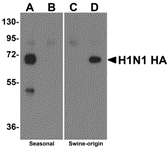Catalog# : 5235
Influenza A virus is a major public health threat, killing more than 30,000 people per year in the USA (1). In early 2009, a novel swine-origin influenza A (H1N1) virus was identified in specimens obtained from patients in Mexico and the United States (2). The virus spread quickly around the world and on June 11, 2009, the World Health Organization declared it a pandemic (3). Influenza A virus has one of sixteen possible Hemagglutinin (HA) surface proteins and one of nine possible neuraminidase (NA) surface proteins. The Hemagglutinin protein facilitates viral attachment while neuraminidase is involved in viral release. These proteins also elicit immune responses that prevent infection or independently reduce viral replication. The genetic make-up of this swine flu virus is unlike any other: it is an H1N1 strain that combines a triple assortment first identified in 1998 including human, swine, and avian influenza with two new pig H3N2 virus genes from Eurasia, themselves of recent human origin (4). The distinct antigenic properties of the new swine virus compared with seasonal influenza A (H1N1) virus suggest that human immunity against new swine influenza virus is limited, although the age distribution of reported cases suggests some degree of protection in older age groups (5). This antibody is specific for the seasonal H1N1 influenza Hemagglutinin and will not recognize the corresponding Hemagglutinin sequence from the swine-origin H1N1 influenza (A/California/14/2009 (H1N1)).
Additional Names : Seasonal Influenza A (H1N1) Hemagglutinin Antibody, Seasonal Influenza A (H1N1) Hemagglutinin, Common flu H1, flu H1, HA
 Description
DescriptionLeft: Western blot analysis of Hemaggutinin using recombinant seasonal Hemagglutinin (lanes A & B) and swine-origin Hemagglutinin (lanes C & D) with anti-seasonal Hemagglutinin antibody (5235) at 2 µg/ml (lanes A & C) and anti-swine-origin Hemagglutinin antibody (5237) at 2 µg/ml (lanes B & D).
Below:Seasonal Hemagglutinin antibody at 2 µg/ml specifically recognizes seasonal influenza virus A H1N1 but not swine-origin influenza virus (S-OIV) A H1N1 Hemagglutinin protein.
ELISA results using Seasonal H1N1 Hemagglutinin antibody at 1 µg/ml and the blocking and corresponding peptides at 50, 10, 2 and 0 ng/ml.
Source :Hemagglutinin antibody was raised against a synthetic peptide from the Hemagglutinin protein.
The peptide sequence is unique from the peptide sequence for product 5231 and 5239.
This antibody is a cognate pair with antibody 5237.
Purification : Affinity chromatography purified via peptide column
Clonality and Clone : This is a polyclonal antibody.
Host : Seasonal H1N1 Hemagglutinin antibody was raised in rabbit.
Please use anti-rabbit secondary antibodies.
Application : Hemagglutinin antibody can be used for the detection of the Hemagglutinin protein from the H1N1 strain of common influenza A in ELISA. It will detect 2 ng of free peptide at 1 µg/ml and will not cross-react with peptide corresponding to the swine-origin H1N1 influenza Hemagglutinin.
Tested Application(s) : E, WB
Buffer : Antibody is supplied in PBS containing 0.02% sodium azide.
Blocking Peptide :Cat.No. 5235P - Seasonal H1N1 Hemagglutinin Peptide
Long-Term Storage : Seasonal H1N1 Hemagglutinin antibody can be stored at 4ºC, stable for one year. As with all antibodies care should be taken to avoid repeated freeze thaw cycles. Antibodies should not be exposed to prolonged high temperatures.
Species Reactivity : V
GI Number : 168805691
Accession Number : ACA28844
Short Description : Seasonal Influenza A (H1N1) Hemagglutinin
References
1. Thompson WW, Shay DK, Weintraub, et al. Mortality associated with influenza and respiratory syncytial virus in the United States. JAMA 2003; 289:179-186.
2. Novel Swine-Origin Influenza A (H1N1) Virus Investigation Team, Dawood FS, Jain S, et al. Emergence of a novel swine-origin influenza A (H1N1) virus in humans. N. Engl. J. Med. 2009; 360:2605-15.
3. Butler D. Swine flu goes global. Nature 2009; 458:1082-3.
4. Morens DM, Taubenberger JK, and Fauci AS. The Persistent Legacy of the 1918 Influenza Virus. N. Engl. J. Med. 2009; Jun

No comments:
Post a Comment